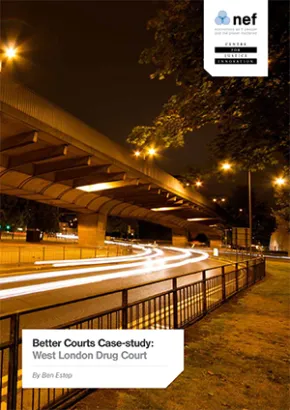West London Drug Court, which ran from 2007 to 2013 at Hammersmith Magistrates Court was a pioneering project which sought to establish a problem-solving court, which combines punishment with help, within a normal English magistrates’ court.
Drug Courts sentence work with people who are committing crime as a result of their drug habits. They sentence them to compulsory drug treatment and bring them back regularly before the court to review their progress. They have been shown in the US to reduce reoffending and help people stop using drugs. In England and Wales, we have adopted part of the drug court model, by giving all courts the powers to order people into drug treatment as part of a community order or suspended sentence. However, reviews of drug treatment only happen very rarely.
West London Drug Court aimed to introduce more of the evidence-backed American model to the UK. It introduced specialist court sessions for drug-related cases, a systematic approach to reviews and closer links between the court and drug treatment agencies.
Though it started with support from a Home Office Pilot, the West London Drug Court operated for several years within the existing resource of local agencies, demonstrating that problem-solving can be done without a significant extra investment.
Tackling drug addiction
West London offered three innovations which aimed to make drug treatment more effective:
- Dedicated drug court sessions: Drug court cases were heard in weekly sittings which were overseen by specialist judges and magistrates who received extra training around drug addiction. The sessions were split in half, with new cases sentenced in the morning and existing cases reviewed in the afternoon. The court also found that by grouping drug-related cases into one sitting, they also made it easier for other agencies to work with offenders in court, as they knew when to come to court to meet potential clients.
- Systematic reviews of drug treatment: Offenders given drug rehabilitation requirements by the court were usually required to regularly return to court to discuss their progress with judges and magistrates. When magistrates were supervising, both offenders and magistrates were scheduled to be in court every six weeks, so that the offender would have the same reviewers each time.
- More collaboration: The drug court provided a platform for many different agencies working with offenders to come together. It brought together a multi-agency steering group where judges, magistrates police, probation, the court service, and others could come together to discuss the work of the court and other issues around drug abuse.
Lessons for problem-solving
The West London Drug Court demonstrates that it is magistrates’ courts can ensure dedicated sittings, and consistent sentencer supervision with little or no additional funding or powers. This is important because these are important to the success of problem-solving: a collaborative, team-based approach, and the continuous involvement of engaged judges who are positively perceived by clients, have been identified as key components of successful drug courts.
